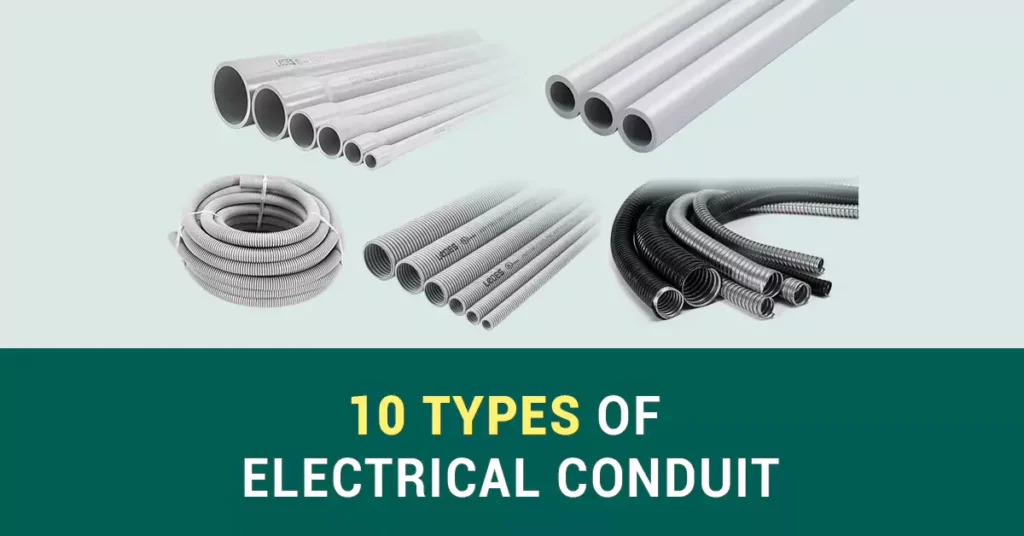
Índice
Neste guia completo, exploraremos os 10 tipos de conduítes elétricos, os prós e os contras e as 10 principais dicas sobre conduítes elétricos de PVC antes de comprar. Vamos começar.
Eletrodutos elétricos são sistemas de tubos, tubulações ou canais utilizados para proteger e direcionar fios elétricos em edifícios, residências e ambientes industriais. Eles atendem a diversas finalidades críticas:
- Proteção: O eletroduto fornece proteção física para fiação elétrica, cabos e condutores, protegendo-os de danos causados por impactos, umidade, produtos químicos e outros fatores ambientais. Ajuda a prevenir o contato acidental com fios energizados, reduzindo o risco de choques elétricos e incêndios.
- Roteamento e Organização: O conduíte ajuda a organizar e encaminhar fios e cabos elétricos de forma estruturada. Permite uma instalação organizada e organizada, facilitando a identificação e o rastreamento de circuitos ou cabos específicos ao solucionar problemas ou fazer alterações.
- Aterramento: Sistemas de conduítes podem servir como um caminho de aterramento eficaz para equipamentos e circuitos elétricos. Ao conectar conduítes metálicos aos sistemas de aterramento, eles ajudam a dissipar falhas elétricas e fornecem uma medida de segurança adicional contra falhas e surtos elétricos.
- Flexibilidade futura: A instalação de conduítes oferece flexibilidade futura, permitindo fácil modificação, expansão ou substituição de fiação e cabos elétricos. Simplifica o processo de adição ou atualização de sistemas elétricos, reduzindo a necessidade de retrabalhos extensos e minimizando interrupções na infraestrutura existente.
Existem muitos tipos de conduítes elétricos disponíveis, cada um com suas próprias características e aplicações. Aqui estão 10 tipos comuns de conduítes elétricos:
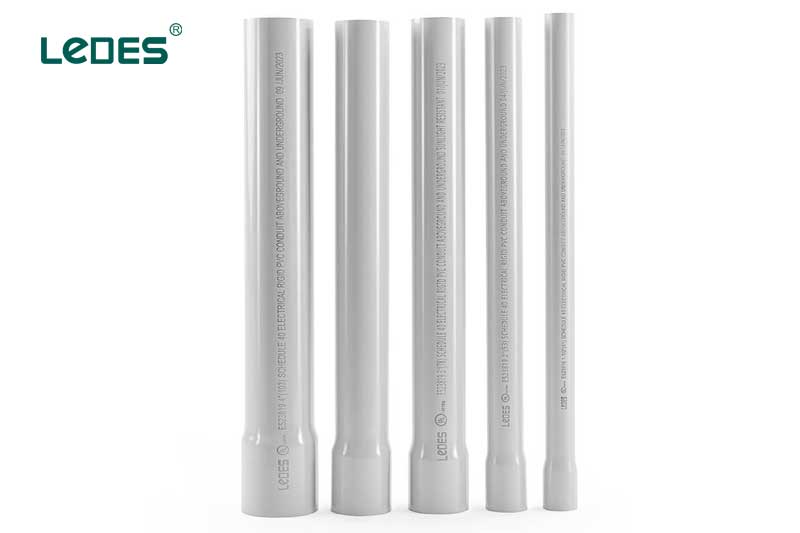
Conduíte de PVC rígido, também conhecido como tubo de PVC, é uma escolha popular para instalações elétricas. É feito de um material termoplástico durável, o policloreto de vinila (PVC), que oferece excelente resistência à umidade, produtos químicos e corrosão. O conduíte rígido de PVC está disponível em vários tamanhos e é conhecido por sua estrutura rígida, proporcionando proteção robusta para fios elétricos.
Estrutura rígida para maior proteção.
Excelente resistência à umidade, produtos químicos e corrosão.
Leve e fácil de manusear.
Não condutivo, o que o torna seguro para aplicações elétricas.
Interior liso para facilitar a passagem do fio.
Mais econômico quando comparado às opções de conduíte metálico.
Adequado para instalações acima e abaixo do solo.
Resistente à luz solar e aos raios UV.
Pode suportar uma ampla faixa de temperaturas.
Ideal para aplicações residenciais, comerciais e industriais.
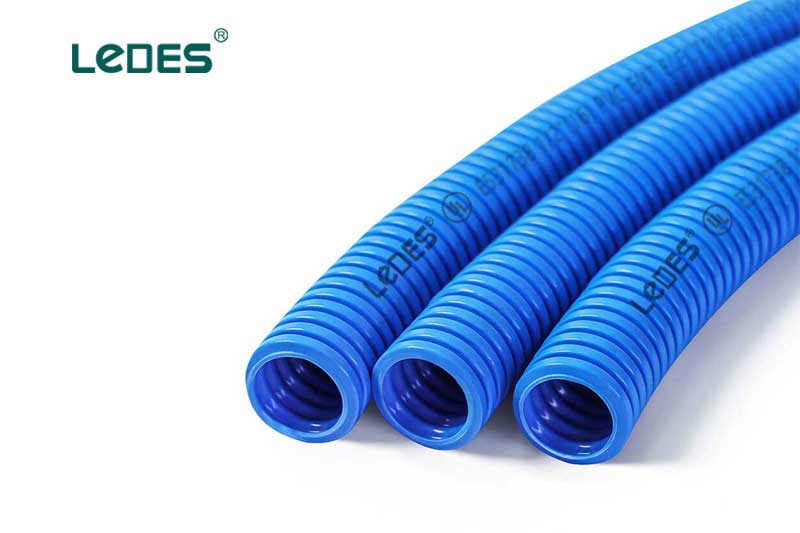
Conduto ENT É um conduíte plástico corrugado e flexível, fácil de manusear e instalar. É comumente utilizado em aplicações internas e externas, onde a flexibilidade é necessária, pois pode ser dobrado manualmente em campo sem a necessidade de ferramentas especiais e oferece boa proteção contra umidade. O conduíte ENT é frequentemente utilizado em fiação residencial, incluindo instalações atrás de paredes e em lajes de concreto.
Flexível e fácil de dobrar.
Exterior corrugado para maior resistência.
Interior liso para puxar o fio sem esforço.
Propriedades retardantes de chamas para maior segurança.
Leve e fácil de manusear.
Resistente à umidade e corrosão.
Adequado para aplicações internas e externas.
Ideal para instalações ocultas e expostas.
Compatível com uma ampla variedade de caixas e conexões elétricas.
Menor resistência ao impacto em comparação aos conduítes rígidos.
Pode exigir suporte adicional em instalações horizontais.
Faixa de temperatura limitada em comparação a alguns outros tipos de conduíte.
LFNC é um tipo de conduíte projetado para ser à prova d'água e de poeira. Possui uma capa externa estanque que oferece resistência à umidade, óleos e outros líquidos não perigosos. O LFNC é frequentemente empregado em locais externos e úmidos, onde a proteção contra a exposição à umidade ou a entrada de líquidos é necessária.
Flexível e fácil de dobrar.
Resistente à umidade, óleo e produtos químicos.
Adequado para locais úmidos.
Proporciona alívio de tensão para fios.
Ideal para aplicações externas e subterrâneas.
Resistente à corrosão e ferrugem.
Fácil de instalar e modificar.
Pode ser usado em áreas com exposição a produtos químicos.
Adequado para uso com conexões estanques.
O conduíte de Polietileno de Alta Densidade (PEAD) é uma opção durável e versátil para instalações elétricas. O conduíte de PEAD é feito de polietileno de alta densidade, um termoplástico conhecido por sua excelente resistência, resistência a impactos e resistência química.
Alta resistência e resistência ao impacto.
Leve e flexível.
Resistente a produtos químicos, umidade e radiação UV.
Excelente desempenho a longo prazo.
Adequado para instalações acima e abaixo do solo.
Pode ser usado em diversas condições ambientais.
Resistente à corrosão e à abrasão.
Pode suportar uma ampla faixa de temperaturas.
Ideal para aplicações industriais e externas.
Requer ferramentas especializadas para cortar e unir.
Custo mais alto em comparação a outros tipos de conduíte.
Menos rígidos que conduítes de PVC ou metal.
Eletrodutos metálicos são mais fortes, duráveis e resistentes ao fogo do que os não metálicos. São frequentemente utilizados em ambientes industriais, comerciais e perigosos.
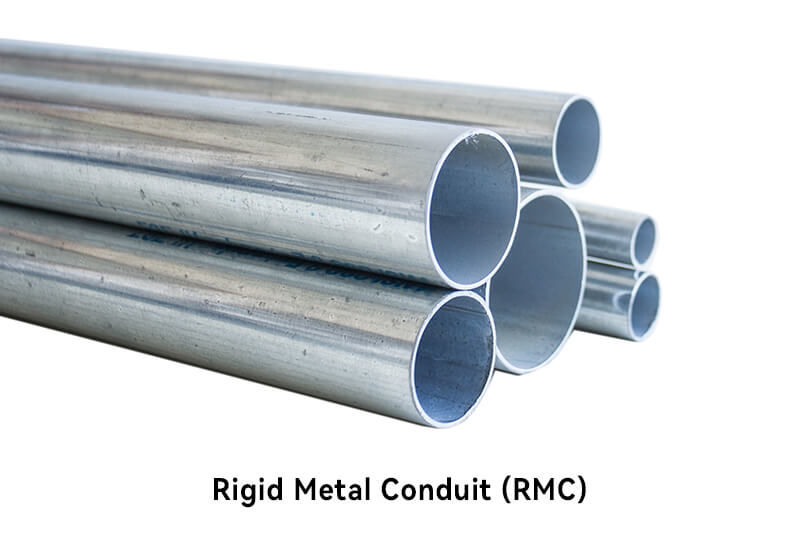
O RMC é um conduíte de alta resistência feito de aço galvanizado ou aço inoxidável, rosqueado para montagem. Oferece excelente proteção mecânica e é adequado para aplicações internas e externas. O RMC é comumente utilizado em ambientes industriais e comerciais onde há risco de danos físicos e altos níveis de proteção são exigidos.
Construção robusta e rígida.
Excelente proteção mecânica para fios.
Alta resistência a impactos e danos físicos.
Fornece caminho de aterramento para sistemas elétricos.
Adequado para locais perigosos.
Oferece proteção máxima contra estresse mecânico.
Resistente ao fogo, calor e corrosão.
Ideal para instalações industriais e comerciais.
Fornece blindagem eletromagnética.
Pode ser usado em aplicações expostas ou ocultas.
Mais pesado e mais difícil de manusear em comparação a outros tipos de conduíte.
Requer ferramentas especializadas para cortar e dobrar.
Custo mais alto em comparação aos conduítes não metálicos.
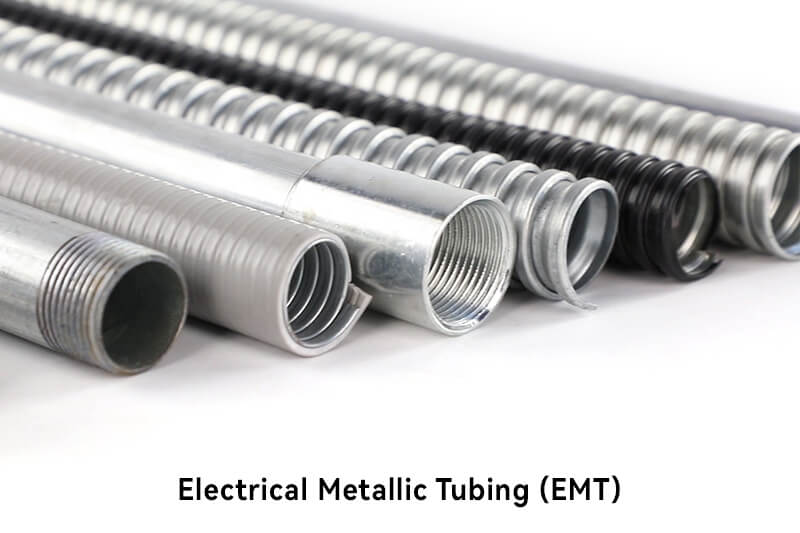
O EMT é um conduíte leve, de paredes finas, feito de aço galvanizado ou alumínio. É mais fácil de dobrar e instalar do que o RMC e é frequentemente utilizado em aplicações residenciais e comerciais leves. É comumente usado para fiação interna exposta em locais secos e úmidos.
Leve e fácil de manusear.
Paredes finas para uso eficiente do espaço.
Interior liso para facilitar a passagem do fio.
Fornece um caminho de aterramento para sistemas elétricos.
Fácil de cortar, dobrar e instalar.
Custo-benefício comparado a outros conduítes metálicos.
Adequado para aplicações expostas e ocultas.
Ideal para instalações residenciais e comerciais leves.
Compatível com uma ampla variedade de acessórios e conexões.
Oferece boa proteção contra danos físicos.
Menos resistente a impactos em comparação ao conduíte metálico rígido.
Adequação limitada para ambientes com alta umidade ou corrosão.
Não recomendado para locais perigosos.
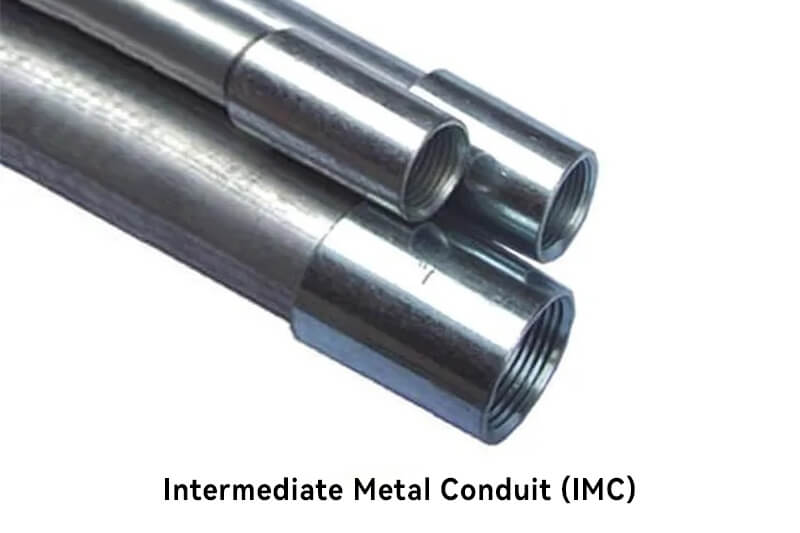
O Eletroduto Metálico Intermediário, conhecido como IMC, é uma opção versátil de eletroduto metálico que oferece um equilíbrio entre a resistência de um eletroduto metálico rígido e a flexibilidade de uma tubulação metálica elétrica. É feito de aço galvanizado e adequado para diversas aplicações de fiação elétrica.
Construção forte e rígida.
Paredes mais espessas em comparação ao EMT para maior proteção.
Resistente à corrosão devido ao revestimento galvanizado.
Fácil de cortar, enfiar e dobrar.
Fornece caminho de aterramento para sistemas elétricos.
Oferece proteção mecânica aprimorada para fios elétricos.
Resistente ao fogo, calor e corrosão.
Adequado para aplicações internas e externas.
Compatível com conexões e conectores padrão.
Fornece blindagem eletromagnética.
Mais pesado e mais desafiador de manusear em comparação ao EMT.
Requer ferramentas especializadas para cortar e dobrar.
Custo mais alto comparado ao EMT.
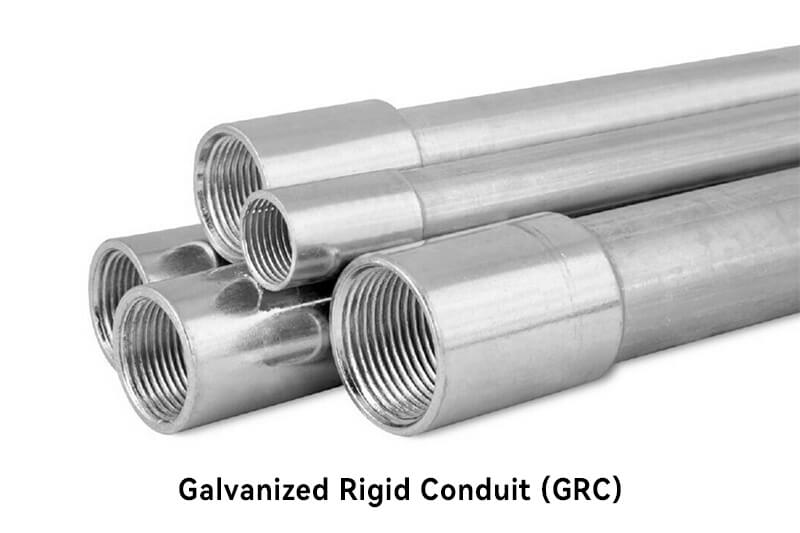
O GRC é o tipo de conduíte metálico mais pesado e durável, feito de aço galvanizado. Oferece proteção mecânica superior, tornando-o ideal para ambientes severos. O GRC é comumente utilizado em aplicações industriais, instalações externas e em ambientes perigosos com risco de incêndio ou explosão.
Construção robusta e rígida.
Revestido de zinco para resistência à corrosão.
Excelente proteção mecânica para fios e cabos.
Fornece caminho de aterramento para sistemas elétricos.
Adequado para locais perigosos.
Oferece proteção máxima contra estresse mecânico e corrosão.
Resistente ao fogo, calor e umidade.
Ideal para aplicações externas e subterrâneas.
Fornece blindagem eletromagnética.
Compatível com conexões e conectores padrão.
Mais pesado e mais difícil de manusear em comparação a outros tipos de conduíte.
Requer ferramentas especializadas para cortar e dobrar.
Custo mais alto em comparação aos conduítes não metálicos.
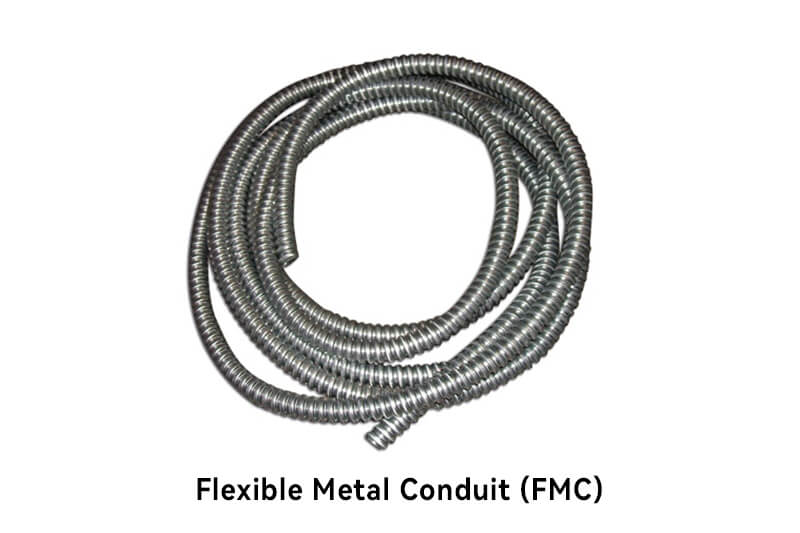
O FMC, também conhecido como "Greenfield", é um conduíte flexível feito de tiras metálicas enroladas em espiral, geralmente de aço galvanizado ou alumínio. Ele oferece boa flexibilidade para a passagem de fios em espaços estreitos ou curvos. O FMC é comumente usado em aplicações internas expostas, onde a flexibilidade é necessária.
Flexível e fácil de dobrar.
Exterior corrugado para maior resistência.
Interior liso para facilitar a passagem do fio.
Fornece caminho de aterramento para sistemas elétricos.
Resistente a impactos e danos físicos.
Oferece flexibilidade no roteamento de fios por espaços complexos.
Adequado para instalações expostas e ocultas.
Compatível com conexões e conectores padrão.
Fácil de cortar, dobrar e instalar.
Oferece boa proteção contra estresse mecânico.
Menos rígido quando comparado ao conduíte metálico rígido.
Adequação limitada para áreas com alta umidade ou ambientes corrosivos.
Não recomendado para locais perigosos.
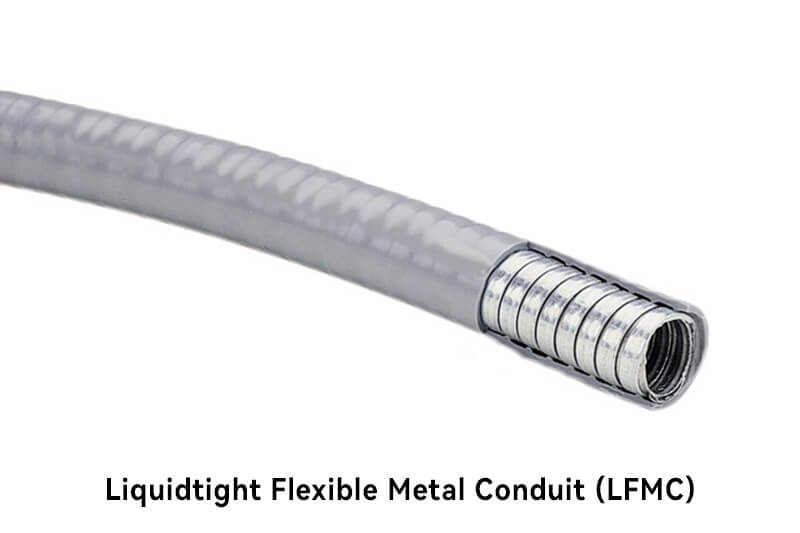
O LFMC possui uma capa externa estanque, que oferece proteção contra água, óleos e outros líquidos. É um tipo de FMC projetado para ser à prova d'água e de poeira. É comumente usado em locais externos e úmidos, como iluminação externa ou áreas expostas à umidade.
Flexível e fácil de dobrar.
Exterior corrugado para maior resistência.
Jaqueta estanque para proteção contra líquidos.
Fornece caminho de aterramento para sistemas elétricos.
Resistente a impactos e danos físicos.
Ideal para locais externos e úmidos.
Resistente à umidade, óleos e produtos químicos.
Proporciona alívio de tensão para fios.
Adequado para uso com conexões estanques.
Compatível com conexões e conectores padrão.
Faixa de temperatura limitada em comparação a alguns outros tipos de conduíte.
Pode exigir suporte adicional em instalações horizontais.
Não é adequado para aplicações de alto impacto ou serviço pesado.
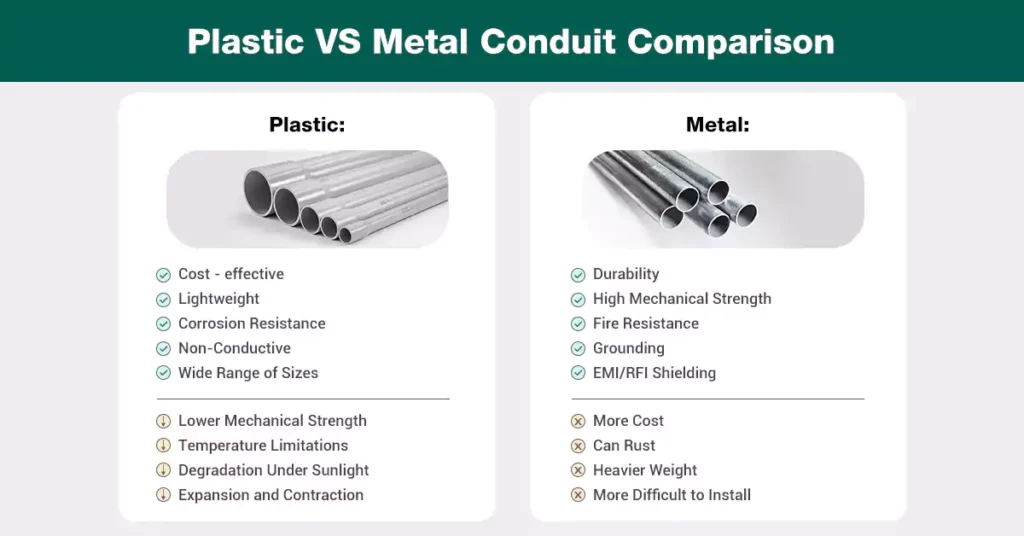
- Custo: Conduítes de plástico, como PVC (cloreto de polivinila) ou PEAD (polietileno de alta densidade), geralmente são mais econômicos do que opções de conduítes de metal.
- Leve: Os conduítes de plástico são leves, o que os torna mais fáceis de manusear e instalar, especialmente em situações de roteamento complexo ou aéreo.
- Resistência à corrosão: Ao contrário dos conduítes de metal, os conduítes de plástico não são suscetíveis à corrosão, o que os torna adequados para áreas com alta umidade, produtos químicos ou substâncias corrosivas.
- Não condutivo: Os conduítes de plástico não são condutores, eliminando a necessidade de aterramento na maioria das aplicações.
- Ampla variedade de tamanhos: Os conduítes de plástico estão disponíveis em vários tamanhos, permitindo flexibilidade na acomodação de diferentes diâmetros de fios ou cabos.
Resistência mecânica: Conduítes de plástico têm menor resistência mecânica em comparação aos de metal. Eles podem não oferecer tanta proteção física à fiação, especialmente em áreas propensas a impactos ou estresse mecânico.
Limitações de temperatura: Conduítes de plástico têm limitações de temperatura e podem não ser adequados para ambientes de alta temperatura ou aplicações onde seja necessária resistência ao fogo.
Resistência UV: Alguns tipos de conduítes plásticos podem se degradar com o tempo quando expostos à radiação UV, portanto, podem exigir proteção UV adicional se usados ao ar livre.
Expansão e contração: Os conduítes de plástico podem expandir e contrair com mudanças de temperatura, o que pode exigir tolerâncias adequadas durante a instalação.
- Durabilidade e Resistência Mecânica: Conduítes metálicos, como RMC, IMC ou EMT, oferecem proteção mecânica e durabilidade superiores, tornando-os ideais para aplicações que exigem blindagem física robusta para fiação.
- Resistência ao fogo: Conduítes de metal geralmente têm melhores propriedades de resistência ao fogo em comparação aos conduítes de plástico, o que os torna adequados para instalações onde a segurança contra incêndio é uma preocupação.
- Aterramento: Conduítes metálicos fornecem um caminho de aterramento para sistemas elétricos, garantindo segurança elétrica adequada e conformidade com os requisitos de aterramento.
- Blindagem EMI/RFI: Conduítes metálicos fornecem blindagem contra interferência eletromagnética (EMI) e interferência de radiofrequência (RFI), o que é benéfico em ambientes com equipamentos eletrônicos sensíveis e para reduzir ruído elétrico.
- Conformidade com os Códigos: Em algumas áreas, os códigos elétricos locais podem exigir o uso de tipos específicos de conduítes metálicos para determinadas aplicações.
Custo: Conduítes de metal, especialmente os rígidos, tendem a ser mais caros do que os de plástico.
Complexidade da instalação: Conduítes de metal podem exigir ferramentas especializadas, como dobradeiras e rosqueadeiras, para corte, dobra e instalação. A instalação também pode exigir mais mão de obra em comparação com conduítes de plástico.
Corrosão: Embora os conduítes metálicos sejam geralmente revestidos ou galvanizados para resistir à corrosão, eles ainda podem ser suscetíveis à ferrugem e degradação ao longo do tempo, especialmente em ambientes corrosivos. Medidas adequadas de proteção contra corrosão devem ser consideradas.
Peso: Os conduítes de metal são mais pesados do que os de plástico, o que pode tornar o manuseio e a instalação mais desafiadores, principalmente em aplicações aéreas ou de longo alcance.
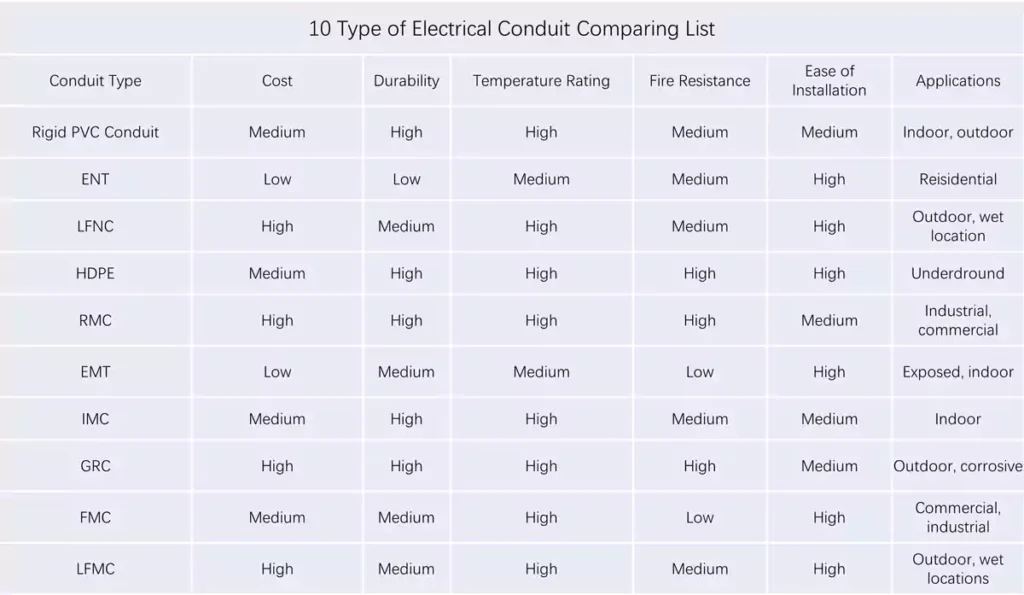
Lista de comparação de 10 tipos de conduítes elétricos
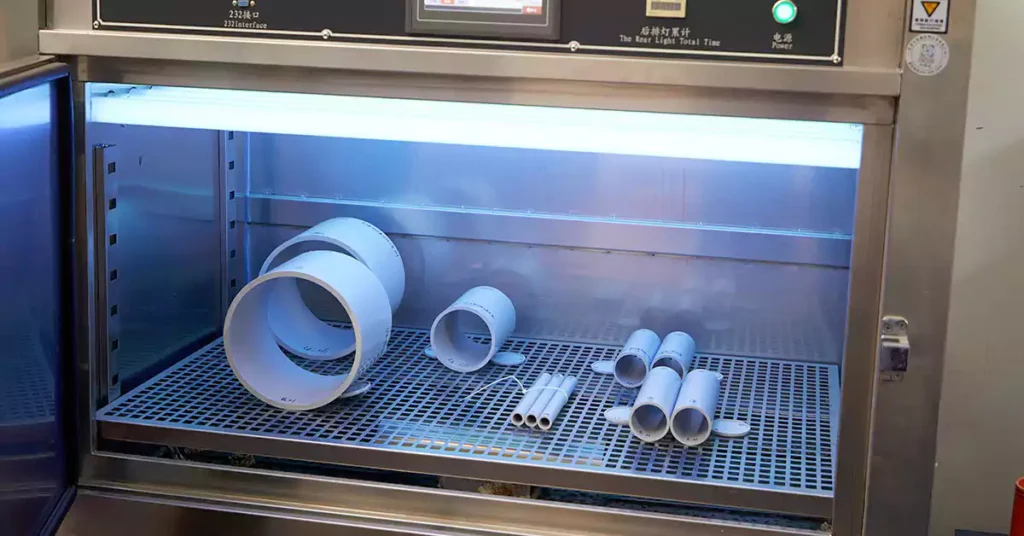
Quando se trata de instalações elétricas externas, a escolha do conduíte correto é crucial para garantir a proteção e a longevidade do sistema de fiação. Ambientes externos apresentam desafios únicos, como exposição a elementos climáticos, radiação UV, variações de temperatura e potencial estresse mecânico. Aqui estão algumas opções de conduítes adequadas para aplicações externas, juntamente com materiais resistentes às intempéries e conexões adequadas:
Conduíte de metal rígido (RMC): Oferece excelente proteção mecânica e durabilidade, tornando-o adequado para instalações externas.
Conduíte metálico intermediário (IMC): O IMC é outra opção para uso externo, oferecendo um equilíbrio entre rigidez e flexibilidade. É adequado para aplicações externas que exigem proteção mecânica moderada, como instalações de iluminação externa ou passagem de conduítes subterrâneos.
Conduíte de PVC: O conduíte de PVC (cloreto de polivinila) é uma escolha comum para aplicações externas devido à sua acessibilidade, resistência à corrosão e facilidade de instalação.
O conduíte de PVC está disponível em diferentes programações, sendo a Programação 40 a mais comum para uso externo.
Conduíte de PEAD: Conhecido por sua excepcional durabilidade e resistência a impactos, produtos químicos e radiação UV, é comumente utilizado em instalações subterrâneas ou enterradas diretamente em ambientes externos.
Ao instalar conduítes ao ar livre, é crucial utilizar conexões e conectores adequados, resistentes às intempéries, que proporcionem uma vedação segura e estanque. Essas conexões podem incluir conexões à prova de intempéries, conectores à prova de chuva, juntas ou conexões de compressão projetadas para uso externo. Além disso, técnicas de vedação adequadas, como o uso de selantes ou fitas adequadas, devem ser empregadas para evitar a entrada de água.
Eletrodutos são componentes essenciais em instalações elétricas, proporcionando proteção, organização e segurança à fiação elétrica. Consistem em tubos, canos ou canais que envolvem e blindam os condutores elétricos, garantindo sua proteção contra danos físicos, umidade, produtos químicos e outros fatores externos. Veja por que e quando os eletrodutos são necessários:
Proteção: O conduíte serve como uma barreira protetora para a fiação elétrica, protegendo-a de danos acidentais, impactos e exposição a ambientes agressivos. Ajuda a prevenir riscos como curto-circuitos, incêndios elétricos e eletrocussão.
Organização: O conduíte permite o roteamento organizado e limpo dos cabos elétricos, facilitando a identificação, a manutenção e futuras modificações ou atualizações.
Segurança: Ao envolver os condutores elétricos, o conduíte reduz o risco de contato acidental, especialmente em áreas onde a fiação fica exposta ou acessível a pessoas ou equipamentos.
Conformidade: A instalação de conduítes geralmente é exigida pelos códigos e regulamentações elétricas locais para atender aos padrões de segurança e garantir práticas de instalação adequadas.
Flexibilidade: O conduíte oferece flexibilidade em termos de futuras expansões ou alterações no sistema elétrico. Permite a adição ou remoção de fios sem a necessidade de grandes retrabalhos ou interrupções.
Edifícios comerciais e industriais: Os códigos locais geralmente exigem o uso de conduítes em edifícios comerciais e industriais para atender aos requisitos de segurança e facilitar a manutenção e as modificações.
Instalações externas: Quando a fiação elétrica é exposta a elementos externos, geralmente é necessário um conduíte para protegê-la contra umidade, radiação UV, variações de temperatura e danos físicos. Isso inclui aplicações como iluminação externa, sistemas de irrigação ou passagem de conduítes subterrâneos.
Locais perigosos: Conduítes são necessários em locais perigosos onde há gases, vapores ou poeiras inflamáveis. Eles ajudam a conter possíveis faíscas ou falhas elétricas, reduzindo o risco de ignição e explosões.
Áreas propensas a estresse mecânico: Eletrodutos são necessários em áreas com alta probabilidade de estresse mecânico, como canteiros de obras, instalações industriais ou áreas com maquinário pesado. Eles oferecem proteção adicional contra impactos acidentais, vibrações ou esmagamentos.
Espaços públicos: Em espaços públicos como escolas, hospitais ou prédios governamentais, o conduíte geralmente é necessário para aumentar a segurança elétrica, evitar adulterações e facilitar a manutenção eficiente.
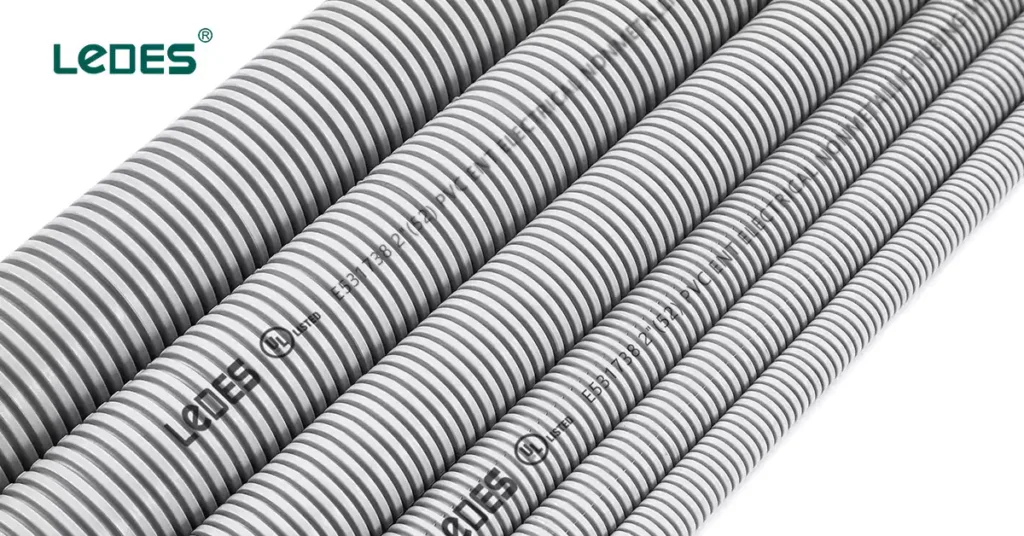
Selecionar o conduíte adequado para sua instalação elétrica é essencial para garantir segurança, conformidade e funcionalidade. Aqui está um guia sobre como escolher o conduíte certo, levando em consideração vários fatores:
- Material:
Avalie as opções de materiais disponíveis para conduítes, como PVC, metal (por exemplo, aço ou alumínio) ou conduíte flexível (por exemplo, estanque ou corrugado). Considere as propriedades específicas de cada material, como durabilidade, resistência à corrosão e adequação à aplicação pretendida.
- Fatores ambientais:
Avalie as condições ambientais onde o conduíte será instalado, como exposição à umidade, produtos químicos, temperaturas extremas ou estresse mecânico.
Escolha um material de conduíte que suporte essas condições. Por exemplo, conduítes de PVC são resistentes à umidade e à corrosão, enquanto conduítes metálicos oferecem melhor proteção contra estresse mecânico.
- Resistência mecânica:
Determine a resistência mecânica necessária com base na aplicação. Considere fatores como resistência ao impacto, capacidade de carga, resistência à pressão e capacidade de suportar vibrações ou forças externas.
- Local de instalação:
Considere a localização específica da instalação do conduíte, seja ela interna, externa, subterrânea ou exposta.
Diferentes locais podem exigir diferentes tipos de conduíte. Para instalações externas ou subterrâneas, você pode precisar de conduítes com maior durabilidade e resistência às intempéries.
- Resistência a produtos químicos:
Avalie se o conduíte será exposto a produtos químicos ou substâncias corrosivas. Escolha um material que ofereça resistência adequada a essas substâncias para garantir desempenho e segurança a longo prazo.
- Certificações:
Procure conduítes que atendam aos padrões e certificações do setor relevantes para a sua aplicação. Exemplos incluem as certificações UL (Underwriters Laboratories) para segurança elétrica nos EUA, as certificações CSA para conduítes no Canadá e as certificações AS/NZS na Austrália. Entenda os códigos e regulamentos locais para conduítes elétricos e escolha os fornecedores que já obtiveram as certificações do produto.
- Flexibilidade e modificações futuras:
Considere a necessidade de flexibilidade no seu sistema elétrico. Você precisará fazer modificações, adições ou atualizações futuras?
Opções de conduítes flexíveis, como conduítes metálicos flexíveis estanques ou conduítes flexíveis não metálicos, proporcionam acesso mais fácil e permitem alterações sem retrabalho extenso.
- Tamanhos e dimensões:
Determine o tamanho e as dimensões apropriados do conduíte com base na quantidade e no tamanho dos cabos ou fios que serão alojados nele. Certifique-se de que o conduíte selecionado possa acomodar a capacidade necessária.
- Marcas:
Pesquise marcas confiáveis que ofereçam conduítes de alta qualidade e tenham um histórico de confiabilidade.
Considere fatores como a reputação da marca, avaliações de clientes e a disponibilidade dos produtos na sua área.
- Custo e disponibilidade:
Avalie a relação custo-benefício e a disponibilidade das opções de conduíte.
Compare os custos de diferentes materiais de conduíte, considerando tanto o custo inicial quanto os requisitos de manutenção de longo prazo.
Certifique-se de que o conduíte escolhido esteja prontamente disponível em sua área para evitar atrasos no processo de instalação.
Lembre-se de consultar profissionais da área elétrica, como eletricistas ou engenheiros, para obter recomendações específicas com base nos requisitos do seu projeto. Eles podem fornecer informações valiosas e garantir a conformidade com as normas locais.
Aqui estão alguns projetos dos quais a Ledes participou e os tipos de conduítes que fornecemos para esses projetos.

O Champlain Hudson Power Express® (CHPE) é um projeto inovador de transmissão de energia renovável que visa fornecer energia limpa e confiável para Nova York. Este projeto de cabo de energia submarino e subterrâneo de corrente contínua de alta tensão (HVDC) conectará a região de Quebec ao bairro de Astoria, no Queens, na cidade de Nova York.
O projeto CHPE desempenha um papel significativo na transformação energética do estado, reduzindo as emissões de gases de efeito estufa e contribuindo para um meio ambiente mais limpo. Seu objetivo é reduzir a dependência de combustíveis fósseis e promover a adoção de fontes de energia renováveis. Ao fornecer energia renovável de baixo custo para Nova York, o projeto não apenas ajuda a atender à demanda energética do estado, como também contribui para o crescimento econômico e a geração de empregos.
O projeto CHPE selecionou Ledes' Listado pela UL Conduíte de PVC Schedule 40 como o conduíte de escolha para sua instalação elétrica. O conduíte de PVC rígido Schedule 40 da Ledes é uma opção durável e confiável que oferece excelente proteção para a fiação elétrica. Os conduítes de PVC são resistentes à umidade, corrosão e diversos fatores ambientais, tornando-os adequados para aplicações internas e externas. A escolha do conduíte de PVC rígido Schedule 40 da Ledes garante a segurança e a longevidade da infraestrutura elétrica associada ao projeto CHPE.
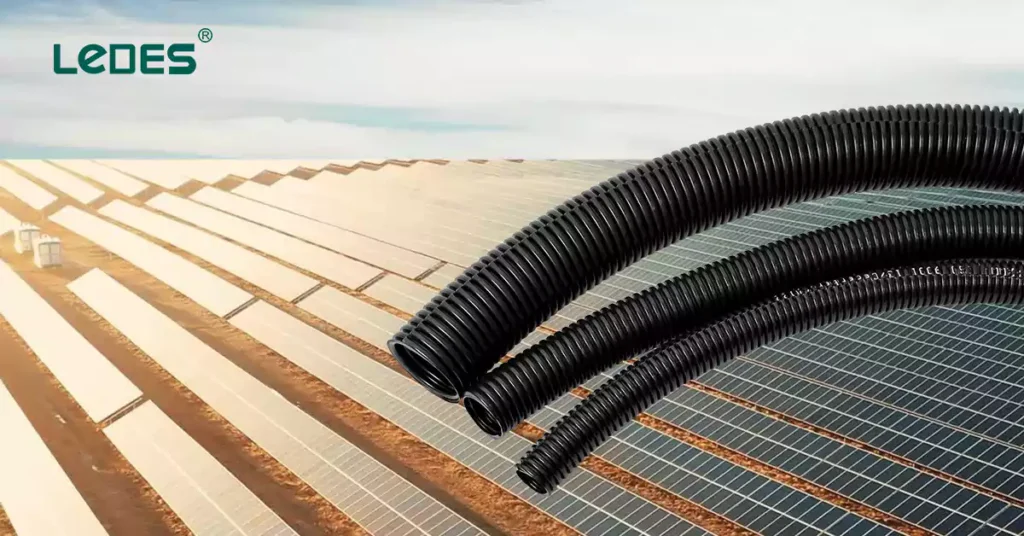
O Projeto de Energia Solar Fotovoltaica Al Dhafrah PV2 e o projeto fotovoltaico de 2,6 GW na Arábia Saudita são os dois maiores projetos solares do mundo. Eles contribuem significativamente para as metas de energia renovável do país e estão comprometidos com a transição para fontes de energia sustentáveis. Esses dois projetos envolvem o desenvolvimento e a implementação de uma capacidade de geração de energia em larga escala de 2 GW e 2,6 gigawatts (GW) utilizando fontes de energia renováveis.
Em linha com as exigências do projeto, Ledes' conduítes corrugados da série solar foram escolhidos como a solução de conduíte. Os conduítes da série solar da Ledes oferecem proteção confiável para a infraestrutura elétrica associada a projetos de energia solar e eólica. Eles são projetados para suportar as exigentes condições ambientais encontradas em instalações de energia renovável, garantindo a segurança e a longevidade da fiação e do cabeamento elétrico.
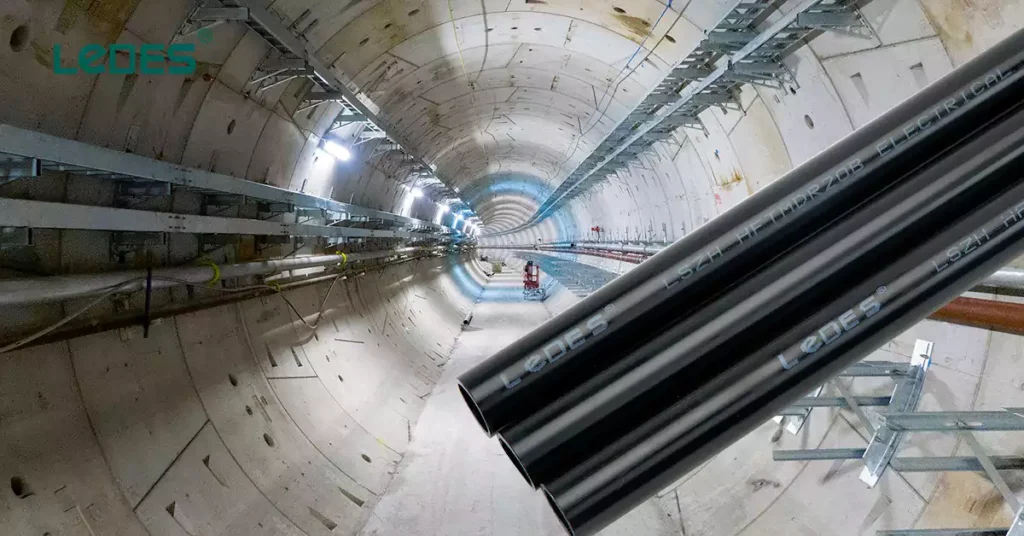
O projeto do Metrô de Melbourne é um dos maiores e mais complexos projetos de infraestrutura da Austrália. O Túnel do Metrô inclui a construção de dois túneis ferroviários de 9 quilômetros com cinco novas estações subterrâneas. Este projeto subterrâneo inclui a instalação de sinalização de alta capacidade e eletricidade operacional, que possui requisitos rigorosos de segurança elétrica e contra incêndio.
Para atender aos requisitos de segurança elétrica, escolheu Ledes' Conduíte de baixa emissão de fumaça e livre de halogênio e conexões para seu sistema de fiação elétrica. Os conduítes livres de halogênio e com baixa emissão de fumaça da Ledes são isolados e oferecem melhor prevenção contra acidentes com choques elétricos. Possuem excelente desempenho de resistência ao fogo, com certificação V0. E não produzem fumaça densa e gases tóxicos durante o incêndio. Oferecem proteção adicional para o sistema elétrico e para o pessoal.
Concluindo, selecionar o conduíte elétrico correto é crucial para garantir a segurança e a eficiência do sistema de fiação. Você precisa entender os diferentes tipos de conduíte elétrico disponíveis e os requisitos específicos do projeto. Considere os fatores discutidos no artigo e suas necessidades específicas para decidir qual tipo de conduíte escolher. Lembre-se de priorizar a segurança, a durabilidade e a conformidade com as normas locais.
Se você não tiver certeza de qual tipo de conduíte elétrico escolher para sua aplicação, A equipe profissional da LEDES pode ajudar a fornecer a melhor solução elétrica para você.



